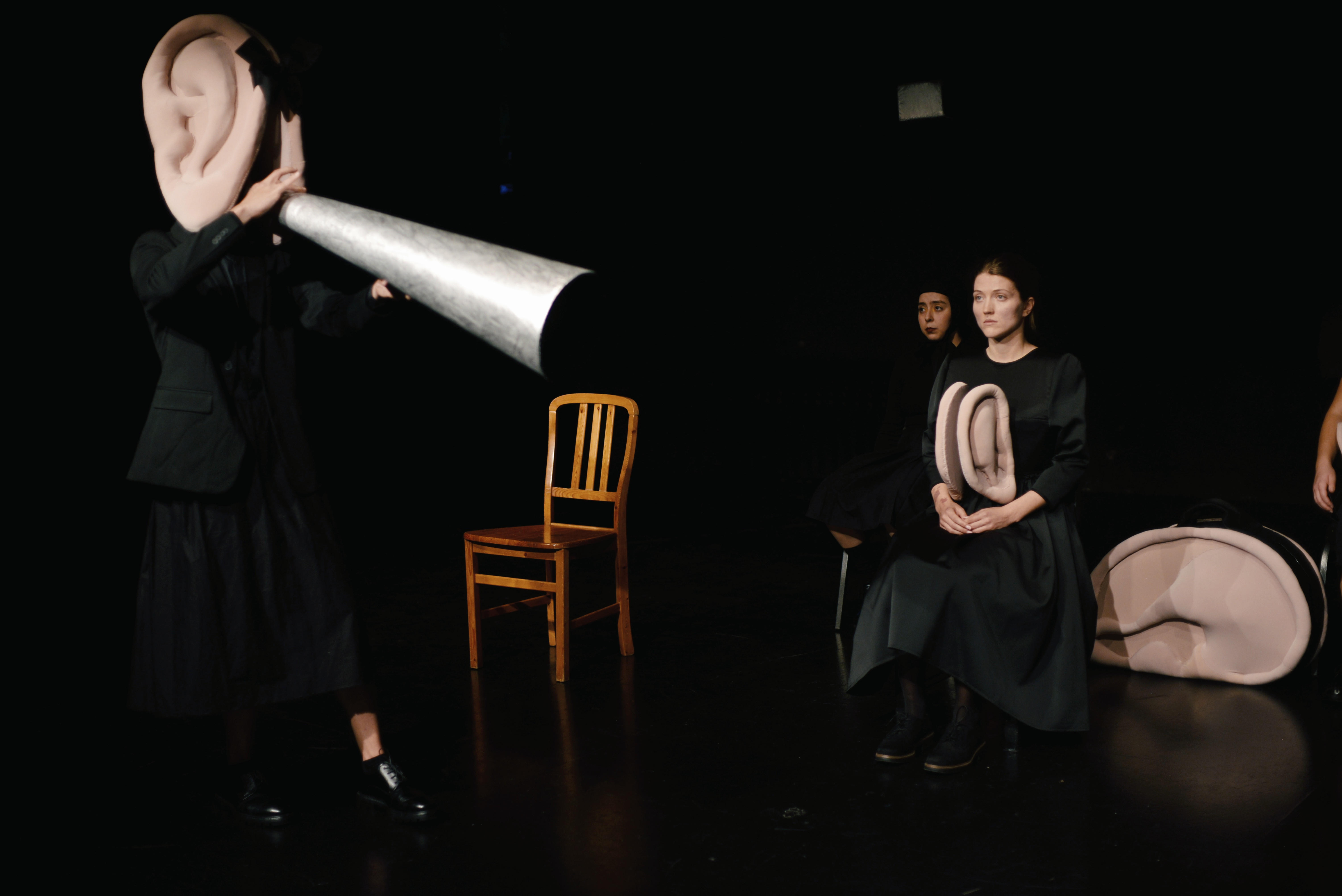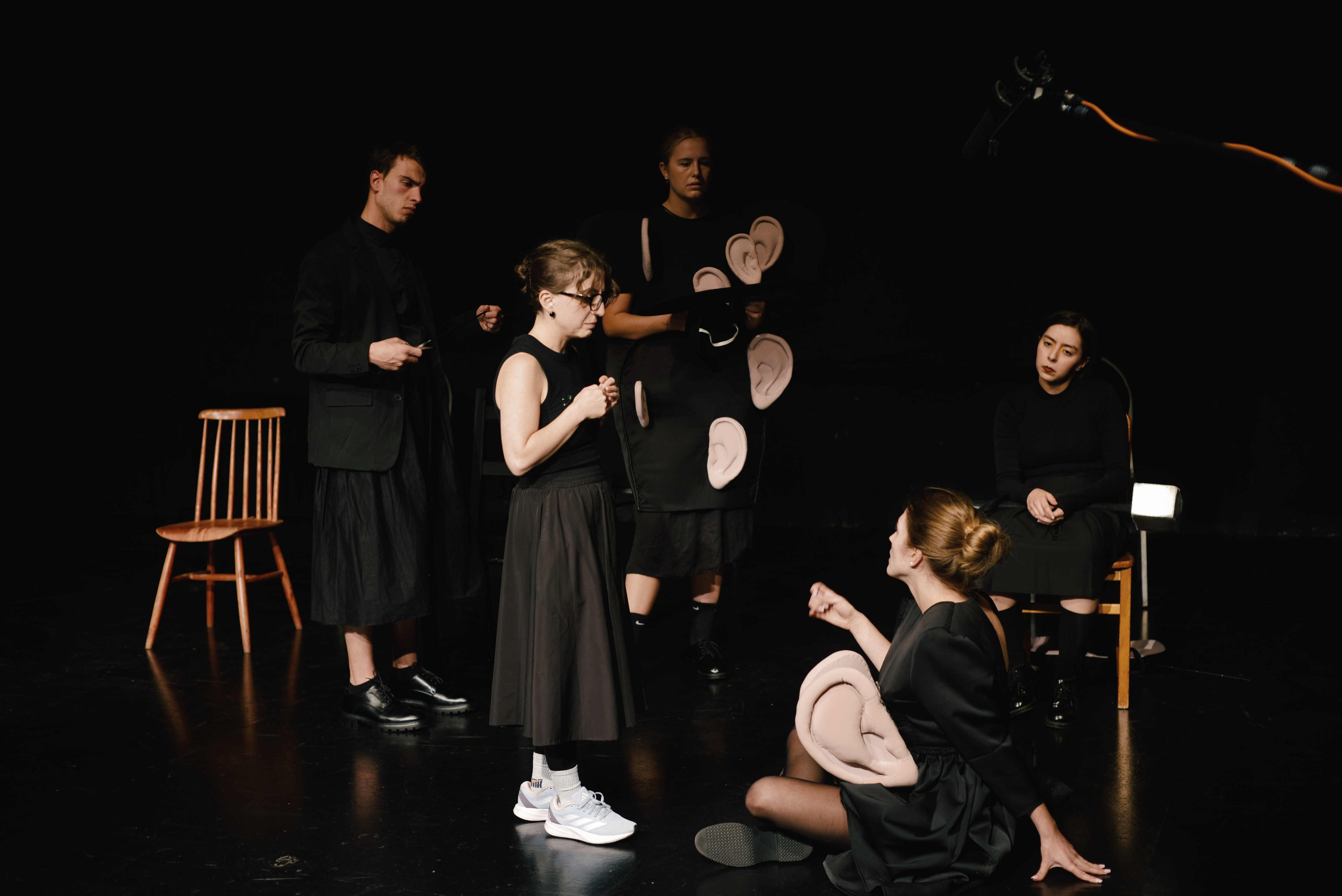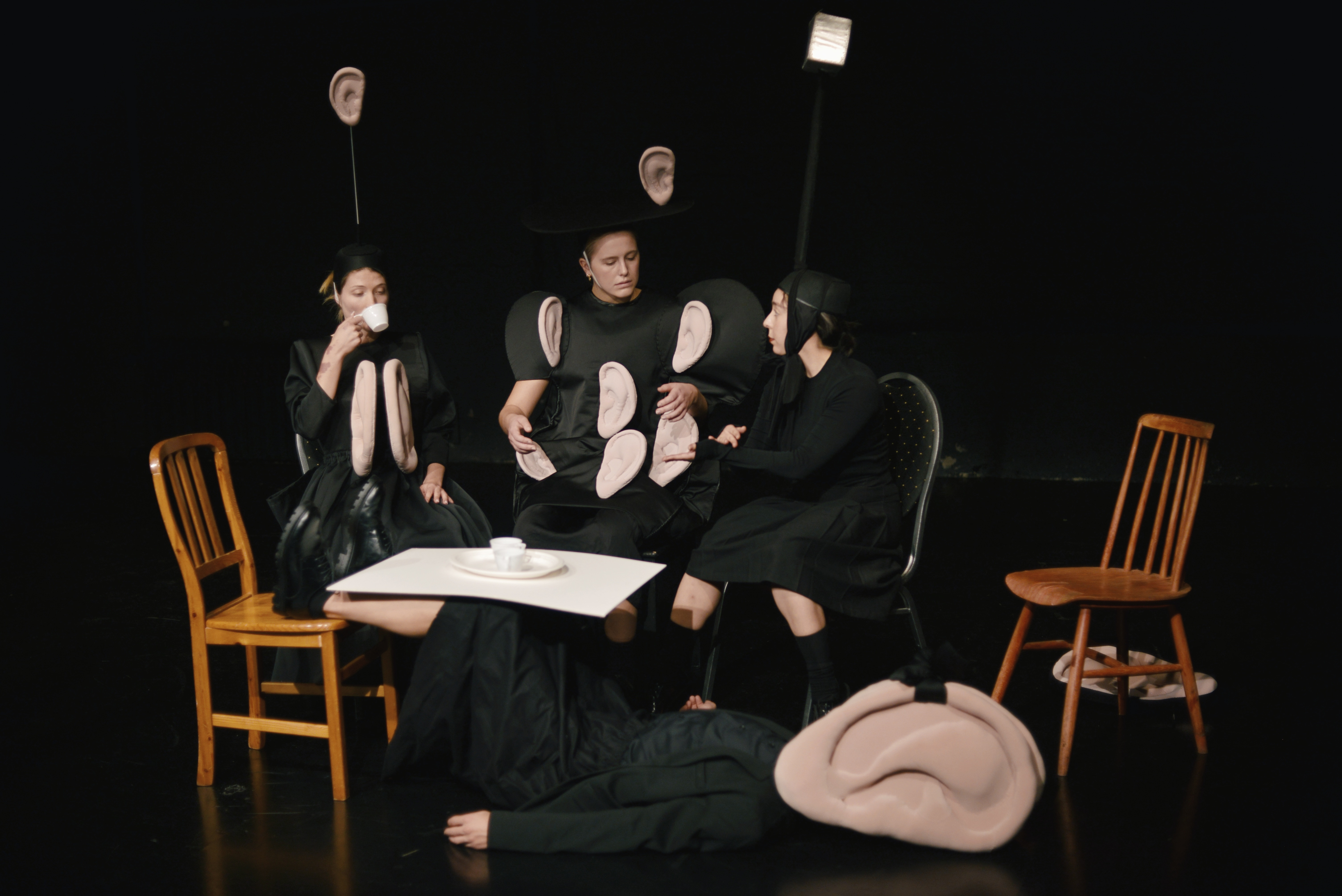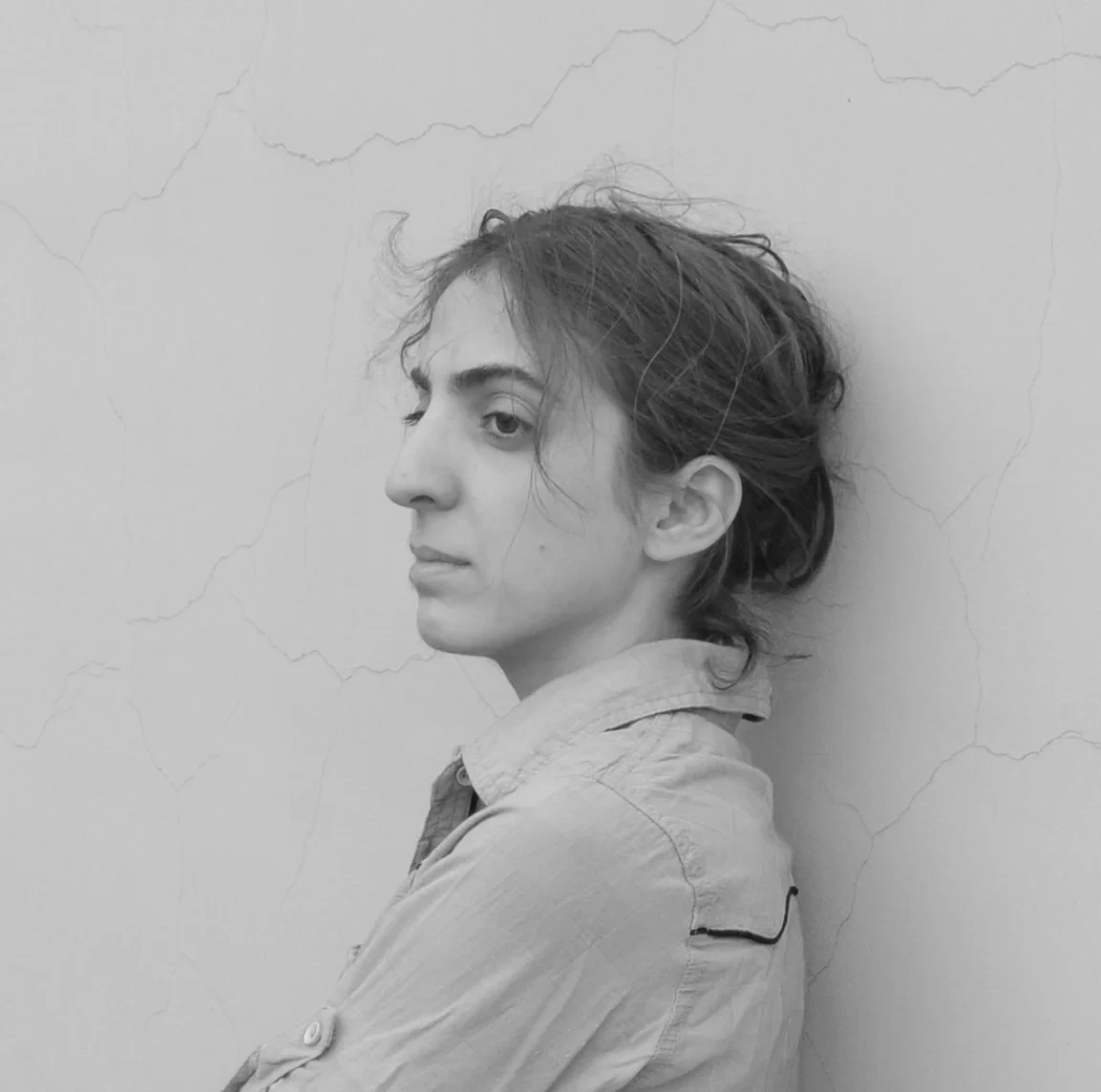The Story of the Ear That Pretended to Be Deaf
In October, the premiere of Venera Kazarova’s performance “The Story of the Ear That Pretended to Be Deaf” took place in Berlin.
This interdisciplinary project lies at the intersection of theater, contemporary dance, and costume design. Its central theme is hearing as a key to interaction with the world and with oneself.
No one truly listens to others — everyone only hears themselves, and even that only partially. We perceive only what we want to hear.
In an ironic twist, ears become decorative elements on the head, as they often fail to fulfill their function. The performance also explores the theme of selective deafness and indifference.
The show will be presented in Frankfurt am Main on November 16, 20, and 21.

— Tell us a little bit about yourself: where are you from, where were you born, in which part of the country, and briefly about your biography.
— Ethnically, I am Armenian. I was born in Russia, but my parents are Georgian Armenians. An Armenian with a Georgian background, so to speak. We speak a dialect, an Armenian dialect of the Georgian language — or vice versa, a Georgian dialect of the Armenian language. In general, our everyday life is Armenian. In Yerevan, for example, not everyone understands me. We have adopted a lot, in general, I consider myself multicultural — I have Georgia, Armenia and Russia.
— How did you get into performance? You studied fashion at first.
— Yes, I started out thinking I would be a fashion designer. Since childhood, I was sure that I would make clothes. I entered the institute and studied to be a fashion designer. And in my final years, I realised that clothes were going crazy, that I was more interested in making unwearable things, working with form. I even wondered if I had chosen the wrong path, maybe I should have studied theatre costume design. But I had already finished my studies. My diploma was completely crazy, but they let me graduate anyway. Then I made costumes that were deliberately unwearable and impractical. I used branches, paper, synthetic padding — everything that makes clothes not clothes. I was interested in working with form. I made costumes like that for a very long time, and then… I know I came to this, but it’s hard to explain how. These are internal processes. The costume became a tool. It became my language because I have something to say. I know about cut, form, composition — but I have an idea, and this knowledge helps me express it. These costumes became my message. I talk to my audience through them.
— Where do you get your inspiration? Who inspires you — in painting, fashion, cinema, literature? Your top three?
— I think it’s obvious.
— Surrealists? Magritte?
— Magritte. I’m a bit embarrassed to talk about it, but my first passion was Dali — he had a big influence on me (laughs). But my top three are: Marcel Duchamp in art, Rei Kawakubo in fashion, and Pina Bausch in choreography.
— How did the idea for the performance ‘The Story of the Ear That Pretended to Be Deaf’ come about? How did this story come about?
— Initially, I had one idea in mind, but since the project lasts a year — from the moment of conception to realisation — I changed my mind many times about what this ear was and what the story was about. At first, I thought it was about people who are apolitical and pretend not to hear anything — a kind of selective deafness. When it suits them, they don’t hear. And then they are punished or suffer the consequences, which are unpleasant. Because I was very concerned about how society exists in Russia… I left in 2022 and was shocked that life in Russia seemed to go on as usual, but it was only an illusion of normality. And then, when I arrived in Germany, I saw that not everything was perfect here either. It’s a complex place, a complex society, with many newcomers, and people don’t always hear each other. And then I realised: it doesn’t matter who hears whom. What matters is hearing yourself. In all this noise, in all this information. Modern people live in a stream of data, and the performance became about connecting with yourself, about how to hear yourself.
— Is that why you chose Beethoven (the composer of the European Union anthem), his ‘Ode to Joy’ — as a metaphor for Europe, where no one hears anyone?
— No, we chose Beethoven because he was a composer who was going deaf. My playwright, Andrei Stadnikov, came up with that. But I like your interpretation too.
— For me, the performance sounds like a cry for help — from an artist who is not being heard. Could we say that it is autobiographical?
— Perhaps, to some extent. Yes, it is difficult for an artist in exile, but I did not put that in directly. After all, I found a venue, the project is going to Frankfurt, and there is a small amount of funding from Kulturamt. It was difficult, I’ve come a long way, but there are results. I can’t say that no one needs me. It’s difficult, but it’s working out.
— Why do you think your project was supported?
Honestly, I think it’s because of the visual aspect. When people see the costumes and presentations, it’s different from what they’re used to. Few people work with image in performance art. I have a combination of visuality and performativity — I think that’s what interested them.
— Do they check the results?
— Of course, everything is documented with photo reports.
— You once said that a costume is a language. When did you first realise that clothes can ‘speak’?
— For a long time, I made costumes just for beautiful photographs. I got into a circle of fashion photographers in Moscow. It wasn’t fashion, it was art fashion. There was no Instagram back then, and I didn’t understand why I was doing it. I tried to get into theatre, but they wouldn’t take me. I didn’t understand how to organise performances or where to start. It was complete incomprehension. I really love the line from Alice in Wonderland when she says, ‘I think I could if I knew how to start.’ That’s how it was for me. And then photographers appeared who were interested in shooting it. I made costumes out of paper and shot them in the studio — just for the sake of shooting. The photos turned out beautiful, and I felt that this was the right direction, but not the end. I wanted movement, life inside the costume, so that it wasn’t the model but the person who breathed life into it. The photos helped me understand what was missing. So gradually I moved on to performance. But even now, this is not the end — the journey continues.
— Do you have any dreams or plans? Who would you like to work with?
— I really want to do projects that aren’t on stage. The traditional ‘hall and stage’ format is difficult for me. I would like to do it in unexpected spaces: on the street, in abandoned factories — places where people aren’t expecting to see a performance. I want there to be about twenty people involved, so that it’s large-scale, like a universal flash mob.
— Tell us about the musical part of the performance.
— The music was written by Alena Toymintseva, who lives in London. We are all like-minded people. I told her the idea, without timing, just the concept. She wrote a 30-minute track, and it perfectly captured the feeling of ‘hearing and not hearing,’ of falling out of reality and returning to it. Then, with playwright Andrey Stadnikov, we created a script, wrote everything down minute by minute, and she added sounds — for example, the sound of a hammer striking, spoons against the ear.

— How did you find the actors?
— Through Instagram. I’ve only been living in Germany for three and a half years, so I don’t know many people in the professional world. I was looking for people in Berlin. An Italian guy came from Milan especially. Although he had written that he was in Berlin. He lives both there and here. They are all performers, contemporary dancers.
— But initially, the idea was about the deafness of Russian society. Did you talk to them about it?
— No, I already talked about the final idea — about inner hearing, about connecting with oneself.
— What would you like the audience to take away from the performance?
— I want everything to be incomprehensible, but impossible to look away from. I want people to not understand what they are looking at, but not be able to look away. I want it to touch them not with their minds, but with their emotions. I want something inside them to rise and then fall. It’s important to me to experience emotions through visuals — for something to fill you up inside, through your eyes. Andrei, the playwright, wrote the story, and I was afraid it would turn out too narrative, too understandable. I want to fill people with emotion, not words. At the end, there’s a moment of Chekhovian peace, but the person is lying on the floor, being used as an object. I want complex emotions — peace through anxiety. I don’t want suffering. I want to talk about complex things without drama, with irony.
— Do you have any idols you would like to work with?
— There was one… he died.
— Wilson?
— Yes. There will never be another like Wilson.
— How does your experience in Berlin differ from that in Moscow?
— I’m not in a position to give advice — I’m figuring it out myself. The difference is in the organisation. Here, everything is planned in advance, everything is discussed. This makes the process more comfortable. No one will call a week before and say, ‘We’re cancelling.’ In Russia, everything was more stressful, with crazy deadlines. I haven’t figured out how to promote art here yet.
— Are there any new projects in the works?
— This performance is my new one. The next one is still in the early stages. I think it will be a continuation — I’ll move on to the other senses: eyes, mouth, nose. I haven’t started yet. I sewed all the costumes for this play myself. This is the first project where I said to myself, ‘I am the director.’ The director of my costumes, my plays. Before that, I had never worked with a playwright or a composer. Everything used to be improvisation. This is my debut.

Text and photo: Anna Malgina
Venera Kazarova
Contemporary artist, costume & performance designer

Venera Kazarova works at the intersection of visual and performative art. Initially, she was a costume designer and received formal education in this field. Her artistic journey began with experimenting with materials and shapes, and eventually, it expanded far beyond costumes themselves.
Kazarova also draws inspiration from dreams and nature. Her performances are often interdisciplinary, combining visual art, contemporary dance, and music. Performance is a vital aspect of her work, as her costumes come to life through movement and embodiment. Together with performers, she creates a visual theater where the costume becomes an extension of the performer’s identity, blurring the lines between art and life.
